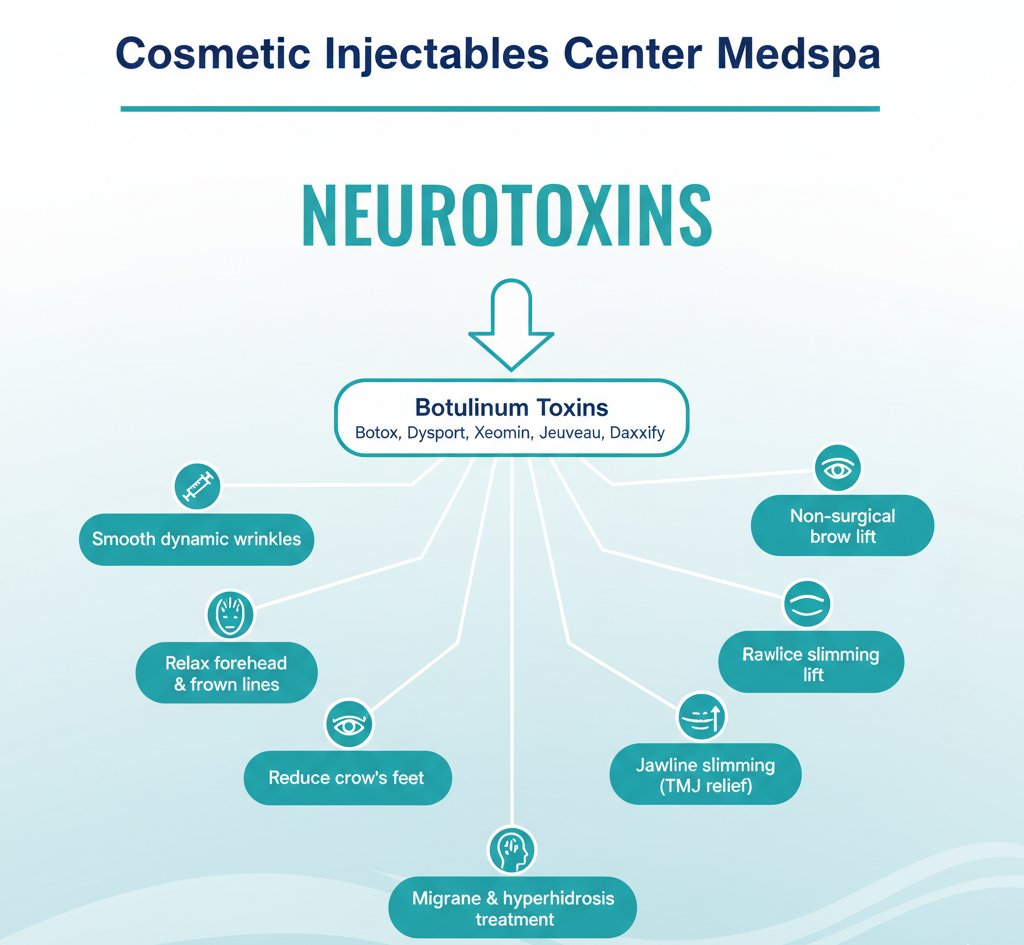Botulinum neurotoxins (BoNTs) are cornerstone agents in both cosmetic and therapeutic medicine, with decades of research supporting their efficacy and safety for wrinkle reduction, muscle spasticity, dystonia, and pain management. At Cosmetic Injectables Center Medspa, all neurotoxin procedures are performed by certified expert injectors under the direct, on-site supervision of Dr. Sherly Soleiman, MD, a board-certified physician and national leader in medical aesthetics.

What Are Botulinum Neurotoxins?
Botulinum neurotoxins are purified proteins derived from Clostridium botulinum. They temporarily block acetylcholine release at neuromuscular junctions, causing reversible muscle relaxation. This mechanism, elucidated in the mid-20th century, underpins both their cosmetic and medical applications (PMC12323300).
Historical Perspective
The therapeutic journey of BoNTs began with 18th-century botulism outbreaks and advanced through key milestones:
- 1822: Justinus Kerner described botulinum toxin’s effects and theorized therapeutic uses.
- 1895: Emile van Ermengem isolated C. botulinum.
- 1940s: Arnold Burgen identified neuromuscular blockade.
- 1970s-1980s: Alan Scott pioneered BoNT-A for strabismus, leading to the first FDA approval in 1989 (PMC10374179).
- 2002: FDA approved Botox for cosmetic use in glabellar lines.
Mechanism of Action
BoNTs are zinc-dependent metalloproteases with two chains:
- Heavy chain: Binds to neuronal receptors (e.g., SV2, synaptotagmin).
- Light chain: Cleaves SNARE proteins (e.g., SNAP-25), blocking acetylcholine release.
This results in targeted, temporary muscle paralysis lasting 3–6 months, depending on the formulation (PMC12323300).
Clinical Applications
Cosmetic Indications
- Wrinkle Relaxation: Forehead lines, glabellar lines, crow’s feet, bunny lines, chin dimpling, platysma bands (Botox for Platysma Bands FDA Approval, 2024)
- Facial Slimming: Masseter reduction
- Brow Lift: Subtle elevation of brow position
- Lip Flip: Relaxation of the upper lip (Lip Flip)
Therapeutic Indications
- Spasticity: Post-stroke, cerebral palsy, multiple sclerosis
- Dystonia: Cervical dystonia, blepharospasm
- Migraine Prevention: Chronic migraine (Botox for Migraines)
- Hyperhidrosis: Excessive sweating (Botox for Underarm Sweating)
- Pain Syndromes: Neuropathic pain, hemifacial spasm, TMJ (Botox for TMJ)
Formulation Comparison
Multiple BoNT-A formulations are FDA-approved, each with unique properties:
| Formulation | Onset | Duration | Immunogenicity Risk | Primary Uses |
|---|---|---|---|---|
| Botox® (onabotulinumtoxinA) | 3–5 days | 3–4 months | Moderate | Cosmetics, dystonia, migraine |
| Dysport® (abobotulinumtoxinA) | 2–3 days | 3–5 months | Higher | Spasticity, wrinkles |
| Xeomin® (incobotulinumtoxinA) | 3–4 days | 3–6 months | Lower | Dystonia, blepharospasm |
| Jeuveau® (prabotulinumtoxinA) | 2–3 days | 3–4 months | Moderate | Glabellar lines |
| Daxxify™ (daxibotulinumtoxinA) | 1–2 days | 6 months | Lower | Wrinkles, peptide-stabilized |
Key Differences:
- Xeomin lacks complexing proteins, potentially reducing antibody formation (PMC12306683).
- Daxxify uses a peptide stabilizer, extending duration to 6 months (FDA Daxxify Approval).
- Botox remains the most widely studied and used for both cosmetic and medical indications.
Efficacy and Safety: Evidence Summary
Meta-Analyses and Clinical Trials
| Study Type | Key Example | Findings | Source |
|---|---|---|---|
| Meta-Analysis | Immunogenicity in CD/Spasticity | Lower secondary treatment failure (STF) and neutralizing antibodies (NAb) with Xeomin; no STF in exclusive users | PMC12306683 |
| Meta-Analysis | Pain in Post-Stroke Spasticity | Small-moderate late-stage benefit; no dose-response | PMC12116153 |
| Clinical Trial | MBA-P01 vs. Botox (Glabellar Lines) | 87% response; higher satisfaction with MBA-P01 at 12–16 weeks | PMC12031167 |
| Clinical Trial | RelabotulinumtoxinA (Frown/Crow’s Feet) | 6-month effect; favorable safety | Galderma News |
| Regulatory | Daxxify FDA Approval | Longer duration than Botox; comparable safety | FDA Daxxify Approval |
Histological and Long-Term Effects
- Short-Term: Muscle degeneration, reduced mitochondrial density, and bone resorption observed in animal models, with partial recovery by 4 weeks (Nature 2025).
- Long-Term: Systematic reviews confirm muscle atrophy and fibrosis; rare granulomatous reactions reported (ScienceDirect 2024; Wiley 2025).
- Safety: FDA boxed warnings for distant toxin spread; updated labels include ptosis and hypersensitivity (Harley Academy 2024; FDA Jeuveau).
Regulatory Updates
- Daxxify approved in 2022 for glabellar lines, offering the longest duration among BoNT-A products (FDA Daxxify Approval).
- Botox received expanded approval for platysma bands in October 2024 (AbbVie News).
- CMS guidelines support use for FDA-labeled indications (CMS LCD).
Procedure Experience at Cosmetic Injectables Center Medspa
All neurotoxin treatments at Cosmetic Injectables Center Medspa are performed by certified expert injectors, with Dr. Soleiman providing direct medical oversight and advanced training. The team employs advanced comfort techniques, including topical numbing, vibration, and the smallest needles, to minimize discomfort and bruising. Each patient receives a thorough medical evaluation and informed consent process, with safety and natural results as the highest priorities.
“My favorite procedure is doing what makes the face look natural… Injectables are a wonderful tool to enhance a person’s confidence, but the result has the opposite effect if they look awkward and out of proportion.” – Dr. Sherly Soleiman, MD (Beverly Hills Magazine)
Internal Links to Related Procedures
- Wrinkle Relaxers
- Botox
- Dysport
- Jeuveau
- Xeomin
- Daxxify
- Botox for Migraines
- Botox for TMJ
- Botox for Underarm Sweating
- Lip Flip
Frequently Asked Questions
For more information or to schedule a consultation with certified experts under the leadership of Dr. Sherly Soleiman, MD, visit Cosmetic Injectables Center Medspa in Sherman Oaks, serving the greater Los Angeles area.
